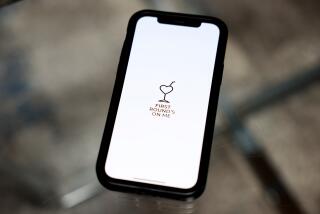One more role for the cellphone: matchmaker
- Share via
The modern dating scene has come to this: a text-messaging service that hits random female subscribers in Los Angeles with such messages as “Hello to all the beautyful ladys.”
Tech-savvy singles are now relying on cellphone-based services to find new dates and friends. The programs help users find strangers to exchange text messages with and even find, on a handset’s digital map, nearby people looking to connect.
Joshua Beaman, a 29-year-old sound engineer from Calistoga, Calif., signed up for one such service, Bouncephone. He soon started texting with Hattie Rohr, a 19-year-old in Wisconsin.
For months, they sent each other messages about music and movies, dinner and work, the mundane things they did every day. Although each exchange was wedged into the 160-character limit on text messages, he said, communicating with Rohr seemed easy. So easy that he finally flew to the University of Wisconsin-Green Bay, where she is now a student, to meet her. They hit it off.
“I’ve paid literally hundreds of dollars for some of those online dating services,” he said. “But I’d never found someone that I’m compatible with.”
First there was phone dating, in which singles would read personal ads and leave each other voice messages. Next came Internet dating, online matchmaking services made more popular by increased access to broadband. Now, with phones accompanying them everywhere, people are turning to mobile dating services.
“With a cellphone, you can do it any time, any place,” said Bob Bentz, director of marketing and sales at Advanced Telecom Services, a Wayne, Pa., company that offers a 350,000-member dating service called MatchLink Mobile. “If you’re waiting for the bus, you can be finding a date.”
Americans now send about 75 billion text messages a month, so it’s natural that the medium has become a popular means of courtship. Speeding the trend is the new generation of handsets equipped with full keyboards, faster Internet connections and global positioning systems that can pinpoint their users’ exact location. In the U.S., about 143 million wireless subscribers have GPS on their phones, according to Nielsen Mobile, and there were 43.3 million active mobile Internet users in August.
Juniper Research projects that the mobile dating industry will see $1.4 billon in global revenue by 2013, from $330 million in 2007 (much of that business currently comes from Japan, where mobile dating is already very popular).
Nurturing a budding relationship or friendship in the limited space of text messages can be tricky. How can two singles discuss a shared love of the Dodgers or an attraction to each other’s photos in just a few abbreviated phrases?
David Crystal, a linguist and author of “Txtng: The Gr8 Db8,” said texters can communicate a surprising amount in 160 characters. “The more you text, the more you realize how you can be clever with your words,” he said. “It’s kind of an art form.”
Beaman, the Bouncephone user, said that emoticons -- those little faces made using letters and characters -- added to his texting lexicon. He would send Rohr a message that said, “I’m stressed :-)” which meant he was tense but OK. The two sent messages so frequently -- about 100 a day -- that it didn’t matter that each was brief.
People don’t need to say much if they’re using their phones to facilitate face-to-face interactions. That’s the purpose behind MeetMoi, a mobile dating service that shows singles which potential mates are nearby so they can text each other to meet up.
“I’m out and I want to meet someone. Why would I go home to my computer and e-mail someone?” said Andrew Weinreich, chief executive of New York-based MeetMoi. “It makes more sense if I’m out and see who’s in a half-mile of me and wants to meet for coffee.”
It may seem creepy -- an invitation for stalkers -- that someone can know when you’re nearby and message you. But the companies say strangers can’t see your phone number or exact location, only your proximity to them. Weinreich says using MeetMoi is no riskier than meeting someone at a bar.
As with any new technology, mobile dating may take awhile to catch on. Dave Max, 30, a MatchLink Mobile member in Salem, Ore., said there are “very, very few” people within 500 miles of him using the service. He has met three of them in person and still exchanges texts with one, but he called each date “a bit weird.”
His texts aren’t exactly the stuff of poetry anthologies: He uses abbreviations such as “LOL” (laugh out loud), “txt” (text), “u” (you) and “pics” (pictures) in his messages and sends blond jokes to people he has never met in person. But he enjoys sending texts and exchanging jokes -- racy and otherwise -- with other singles.
The services are spreading beyond the dating world to friendships. Mobile companies such as Loopt Inc. and Earthcomber help members use their phones to search for others nearby with similar interests, such as cycling or hiking. (By the looks of their profile pages during a recent search, Loopt users near Los Angeles skewed toward shirtless men in their 20s interested in dating.)
It’s a useful resource for people on the go who might want to find a dinner companion when they’re traveling, Earthcomber Chief Executive Jim Brady said.
Or to find where the surf’s up.
Alex Clark, a 35-year-old real estate broker in San Francisco, recently used Loopt to contact a nearby surfer and find out if the waves were breaking better down the beach. He also used it to inform nearby users that he was showing a house in the Haight neighborhood. Two potential buyers said they’d heard about the house on Loopt.
Using the friend-finder for work and play has its drawbacks, though. “I have to turn it off when I go to the beach so my clients don’t know where I am,” Clark said.
Some people may not like the pressures of being always available to strangers through a device in their pockets. It’s socially acceptable to step away from the computer, but not from a mobile phone, said Walter J. Carl, assistant professor of communications studies at Northeastern University.
“Because there is perpetual contact, we feel like we always have to be present,” Carl said.
But Beaman, the Bouncephone user, isn’t bothered. With a text message, you don’t have to write as much as you do in an e-mail, he said, and it can be informal and short. If a text arrives while he’s eating dinner, he can keep flirting.
“I don’t even have to stop chewing if I don’t want to,” he said.
He and Rohr decided not to pursue a long-distance relationship -- yet. But they still exchange text messages every day.
--







